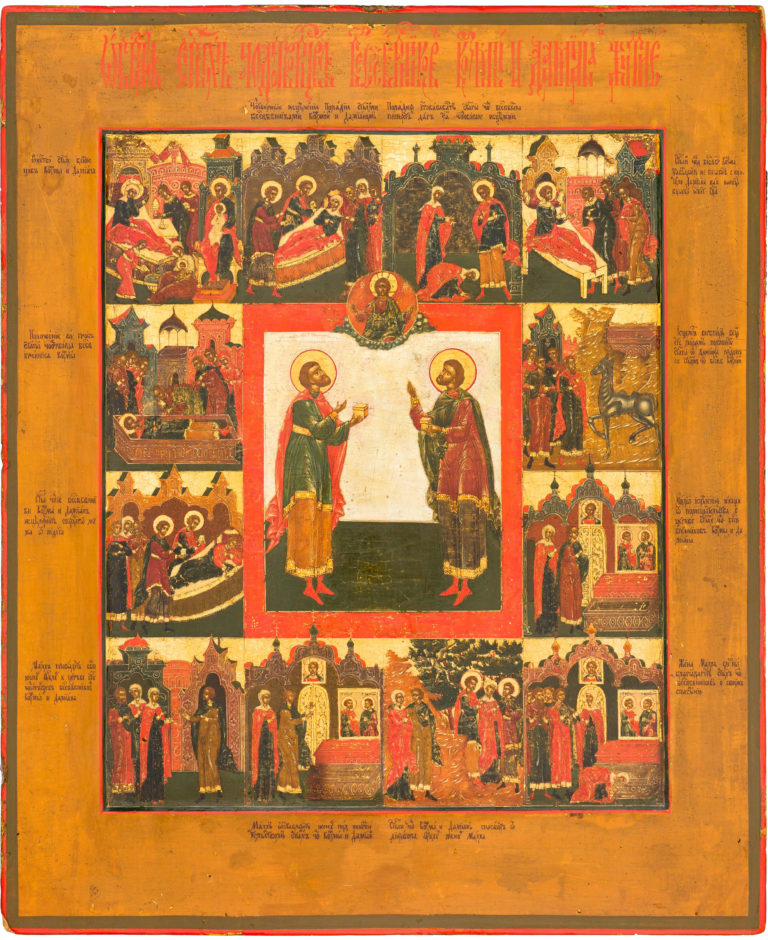Saints Cosmas and Damian of Asia, with 12 Hagiographical Scenes
Antique Russian icon. Second quarter of the 19th century. Guslitsy.
Size: 45 х 37 х 3 cm
Wood (two panels), two incut profiled support boards, a shallow incut centerpiece, underlying layer of canvas is not visible, gesso, tempera.
The author’s paintwork is in good condition with only slightly visible scratches on the upper field, near the side of the religious icon. Small fallouts of gesso on the borders. Several restoration tonings on the bottom field.
Contact us

Saints Cosmas and Damian of Asia, with 12 Hagiographical Scenes
Diagram of the border scenes:
- The Nativity of Saints Cosmas and Damian;
- The Healing of Palladia;
- Palladia convinces Damian to accept a gift in return for her healing;
- Saint Cosmas asks for his body not to be buried with that of Damian, since the latter broke their pledge;
- The Burial of Saint Cosmas;
- A healed camel speaks with the human voice and implores the people to bury Saint Damian alongside his brother;
- Saints Cosmas and Damian cure a sleeping man from his malady;
- The miraculous healing of a mad youth from the relics of the Saints;
- Malch brings his wife Thekla to the Church of Saints Cosmas and Damian;
- Malch leaves his wife under the protection of the Holy Brothers;
- Saints Cosmas and Damian save Thekla from the Devil;
- Thekla tearfully thanks the Holy Brothers for her salvation.
In the Eastern Christian tradition, we see the veneration of three pairs of Holy Brothers known for their healing and medical powers. All of them bear the names Cosmas and Damian. The Arabian and Roman brothers lived in the second half of the 3rd century and were not twins, unlike the Asian brothers (depicted in the given antique Russian icon) who lived in 4th century Asia Minor. The Asian Cosmas and Damian were born in a Greek family. Their mother Theodotia was a Christian, and it was she who taught the brothers the art of medicine and healing. The brothers were known as the Anargyri doctors – meaning that they did not accept payment for their services. Instead, they preached the Christian faith to their patients. The brothers died peacefully without suffering martyrdom and were buried in the same grave. Numerous miracles and healings took place before their relics. Their Feast is celebrated on November 1st, according to the Julian calendar.
The Vita of the Asian Brothers was known in Russia since the pre-Mongolian period that gave rise to their widespread veneration and the commission of the hand-painted icons of saints (including hagiographical ones). The number and the selection of the religious icon border scenes are typical for the later-period Eastern Orthodox iconography. It includes the saints’ nativity and the miracles performed in their lifetime and after their repose (among the former – the healing of Palladia from the unknown malady and the miracle of the camel who spoke in favor of the brothers’ burial together; among the latter – the miraculous healings of the youth who lost his mind, the man whose lung condition was healed in his sleep, and Malch’s wife saved by the Anargyri brothers from the Devil).
The artistic traits and characteristics of this antique Russian icon indicate that it was painted in one of the most significant Old Believer centers – Guslitsy. This rather large area, known as “Old Believer Palestine,” was located along the river Guslitsa in the eastern part of the Moscow Province. Guslitsy was at the forefront of the Old Believer religious icon art, and by the mid-19th century, it became one of the main spiritual centers of the Old Believer Metropolia (the so-called Belokrinitsy Hierarchy). Local artists were known for the production of illustrated books, metalwork, and also hand-painted Orthodox icons that were then spread across Russia. The religious icon painting centers of the nearby Vladimir region (Palekh, Mstyora, Kholuy) influenced the development of the Guslitsy’s style and tradition of painting religious icons. Embracing Palekh’s iconographic and compositional schemes, as well as such techniques as adding the lights on the vestments mixed with the basic tone, local religious icon painters developed their own recognizable style. It is built on a solid use of the ochre-red tone without any contrasting layers; the color scheme is usually dominated by various shades of brown and olive that come into contract with bright reds, bright ochres, emerald greens, and purples. The strong graphic work and the calligraphy of the inscriptions visible on this antique Russian icon reflect the fact that the artists were well acquainted with the craft of book production and illumination – a trait that is also typical for Guslitsy’s religious icon painters.